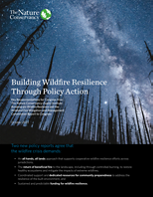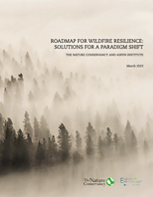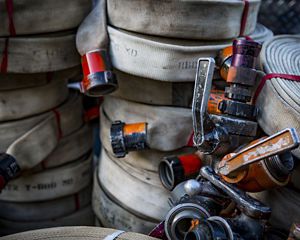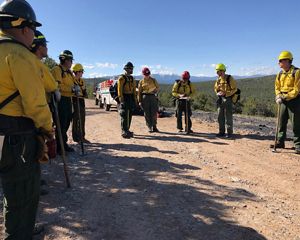In recent years, a surge in catastrophic wildfire events has strained local, state and federal resources destroying communities, lives and livelihoods as wildfires become larger and more destructive in terms of lives lost and economic costs. These wildfire events have become more frequent and severe, resulting from more than a century of fuel build-up due to past land and fire management practices, growing populations moving into and expanding the zone between natural lands and human development known as the wildland-urban interface, the effects of climate change and a lack of funding streams to support wildfire resilience.
These trends are only projected to worsen under future climate scenarios with the annual area burned in the western United States forecasted to increase two to six times from current levels, depending on the geographic area, ecosystem and local climate.
In 2022, TNC partnered with the Aspen Institute to develop a set of transformative wildfire resilience policy solutions. The partnership hosted a series of workshops that sought input from all levels of government, Tribal Nations, the private sector, fire-prone communities, philanthropists, academics and other stakeholders, culminating in the publication in March 2023 of the Roadmap for Wildfire Resilience: Solutions for a Paradigm Shift.
Recommendations and Reports for the Wildfire Crisis
-
 Policy Action for the Wildfire Crisis
Policy Action for the Wildfire CrisisNew report shares key Congressional recommendations and an "all hands, all lands" approach for dealing with the wildfire crisis.
DOWNLOAD -
 A Forward Thinking Approach to Wildfire Resilience
A Forward Thinking Approach to Wildfire ResilienceThe roadmap includes recommendations from decades of policy and practice with eight themes from controlled burning to resilient communities.
DOWNLOAD
Quote: Brent Keith
The Roadmap makes clear an all-of-society approach with state and local governments, Tribal Nations and partners is needed to address the wildfire crisis. Some problems can be managed in the short-term, but most are connected and require long-term, strategic cross-sector coordination.

A prescribed burn at The Nature Conservancy's Derr Tract in Platte River Prairies, Nebraska. One of the eight themes in the Wildfire Resilience Roadmap focuses on the benefits of controlled burning for forest and land health.

What do we mean by Wildfire Resilience?
Wildfire resilience is a suite of actions to help prepare for, recover from and reduce the risks and impacts of wildfire events. The Cohesive Strategy outlined two wildfire resilience pillars: restoring and maintaining landscapes to ensure they are resilient to fire and supporting fire-adapted communities so that humans and infrastructure can withstand a wildfire without loss of life and property.
The Roadmap concentrates on the two pillars of the 2014 National Cohesive Wildland Fire Management Strategy—resilient landscapes and fire adapted communities—that require an investment commensurate with the third pillar, safe and effective wildfire response, to alter the current wildfire trajectory. The Roadmap focuses on actions that can be taken before and after fires to help acheive the first two pillars. It also weaves together lessons from decades of policy and practice with forward-thinking approaches that incorporate new technology and knowledge.
“We’ve developed this Roadmap as an authoritative reference for policy makers and forest health and community advocates,” said Greg Gershuny, Executive Director of the Aspen Institute’s Energy & Environment Program. “Protecting communities from the impacts of climate change, our ability to collectively embrace new strategies will require trust and a willingness to invest in an all-inclusive approach to problem-solving.”
ADDITIONAL WILDFIRE RESILIENCE ROADMAP RESOURCES
Roadmap Policy Recommendations
The roadmap includes recommendations covering eight themes from controlled burning to resilient communities.
-
Landscape Scale and Outcome-Driven
Strengthen capacity, funding and coordination to complete wildfire resilience projects that are landscape scale and outcome-driven among federal, Tribal Nation, state, non-governmental organizations (NGOs) and local and private partners.
-
Controlled Burning
Scale the use of prescribed fire and cultural burning as an essential component of fuels management projects and deploy more intentional use of fire as a needed and ongoing component of fuels project maintenance and ecosystem restoration strategies.
-
Resilient Communities and Landscapes
Enhance support for community mitigation and adaptation of wildfire and smoke and integrate investments in community and landscape resilience.
-
Forest Products
Reduce barriers and incentivize innovation and investment in hazardous fuels byproduct use and related forest products and forest product processing infrastructure.
-
Partnerships, Finance and Insurance
Expand the use of public-private partnerships, conservation finance and innovative insurance mechanisms to support and scale wildfire resilience efforts.
-
Equity and Access
Ensure access to investments and meaningful involvement in decision making for wildfire resilience among historically underserved and marginalized communities as well as communities affected by poverty and inequality.
-
Recover for Resilience
Reform delivery of post-fire management and recovery assistance necessary to ensure that landscapes and communities recover in ways that foster long-term resilience to severe fire risks.
-
Technology and Innovation
Expand the use of innovative technologies to support wildfire resilience through better public and private sector coordination, data and systems interoperability and investments in applied research and technology transfer among multi-sector partners.

The development of the Roadmap’s policy recommendations coincides with a once-in-a-generation infusion of resources from the bipartisan Infrastructure Investment and Jobs Act (IIJA) and the Inflation Reduction Act (IRA).
These two historic pieces of legislation have allocated billions of dollars for wildfire risk mitigation and forest health programs across federal agencies.
Implementation of the Roadmap policy recommendations will strengthen a seamless and urgent all-of-society approach to restore and manage landscapes, reduce impacts and improve the safety of wildfire response actions, and enable communities to better coexist with fire in their landscapes.
Four in five U.S. voters support increased federal investment to proactively reduce the threat and intensity of wildfire.
National public opinion polling conducted by TNC in 2022, with an oversample in the Intermountain West, revealed robust bipartisan support for increased investment in forest health and wildfire prevention. Polling methods and data can be found in the Roadmap appendices.
Strong Bipartisan Support for Wildfire Resilience
Four in five voters support increased federal investment to proactively reduce the threat and intensity of wildfires.
-
77%
Republicans
-
92%
Democrats
-
74%
Independents
Spreading Concern
Wildfires and droughts are top-tier concerns for American voters, just behind inflation, housing and government waste.
Voters' concern about wildfires increased 18% from 2018 to 2022.
39% of voters nationwide know someone who has been impacted personally by wildfires or wildfire smoke.
“Much of what TNC has learned in 60 years of working with fire is mirrored in the Roadmap. It’s an all-of-society approach. We know that working with fire is about working with people, and achieving healthier landscapes and safer communities is going to require a larger and more diverse force of prescribed fire practitioners,” says Marek Smith, director of TNC’s North America Fire program. “It’s going to take every tool—the full suite of recommendations in the Roadmap—and ‘all hands’ using them to apply the good fire we need in the places we need it most.”
The goals of the actions highlighted in the Roadmap are supported by public opinion research conducted in 2022 by FM3 Research and New Bridge Strategy. National polling, with an oversample in the Intermountain West, revealed robust bipartisan support for increased investment in forest health and wildfire prevention. Four in five U.S. voters support increased federal investment to proactively reduce the threat and intensity of wildfire.
Implementation of the Roadmap policy recommendations will strengthen a seamless and urgent all-of-society approach to restore and manage landscapes, reduce impacts and improve the safety of wildfire response actions, and enable communities to better coexist with fire in their landscapes.







